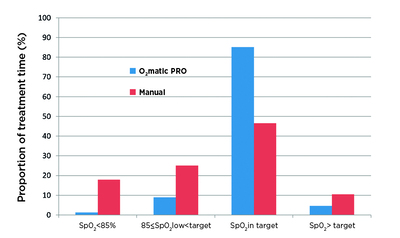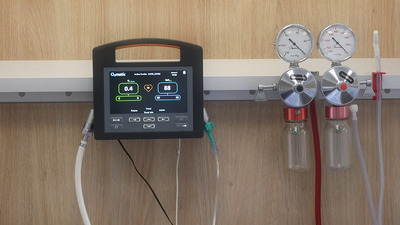O2matic PRO: automated closed-loop oxygen therapy

The O2matic PRO is a novel medical device that brings oxygen treatment to a new level. The technology was developed in close cooperation with four hospitals in Denmark and is demonstrated to quickly stabilise arterial oxygen saturation in patients suffering from conditions that can lead to respiratory distress (1,2).
The O2matic PRO solves the issue of the labour-intensive titration of oxygen flow rates associated with the current manual apparatus. Oxygen flow is automatically titrated responding to real-time arterial oxygen saturation (SpO2) as measured by pulse oximetry. The O2matic PRO controls the dose of oxygen administered to the patient to maintain the SpO2 within a prescribed target range; hence reducing patient–nurse exposure times.
Supplemental oxygen therapy is central to the treatment of respiratory insufficiency caused by a variety of acute and chronic diseases. A clinical study conducted with the use of the O2matic PRO on patients suffering chronic pulmonary diseases demonstrated its ability to keep oxygen saturation within a prescribed bracket with the use of its unique algorithm (1). It shows that the O2matic PRO maintains the oxygen saturation within the specified range 85% of the time, in contrast to 47% achieved by the conventional practice, while decreasing episodes of hypoxemia (1). Another study conducted on admitted patients of the 2020 pandemic also demonstrated similar achievements. Using the O2matic PRO, medical staff were able to maintain patient oxygen saturation within the prescribed bracket 83% of the time (2).
Patient arterial oxygen saturation levels during oxygen treatment
Key benefits of closed-loop oxygen therapy:
- Improving patients’ time within the target SpO2 levels (1,2), hence reducing mortality rates (3).
- Reducing oxygen consumption by up to 50% (4).
- Faster weaning from oxygen and reducing length of stay (5).
- Reduction in costs of care (6) and patient–nurse exposure times.
Automatic closed-loop oxygen therapy has been the subject of many more clinical studies with promising outcomes. To request a summary of clinical studies and technical features, please visit our website www.boc.com.au/o2matic.
1800 050 999 | healthcare@boc.com | www.boc.com.au/o2matic
References
1. Automated oxygen control with O2matic ® during admission with exacerbation of COPD. Hansen, Ejvind Frausing, et al. 13, s.l. : International Journal of Chronic Obstructive Pulmonary Disease, 2018, Vol. 14, pp. 3997-4003.
2. Automatic oxygen titration with O2matic® to patients admitted with COVID-19 and hypoxemic respiratory failure. Hansen, Ejvind Frausing, et al. 1, s.l. : European Clinical Respiratory Journal, 2020, Vol. 7.
3. Mortality and morbidity in acutely ill adults treated with liberal versus conservative oxygen therapy (IOTA): a systematic review and meta-analysis. Derek K, Chu, et al. 391(10131), s.l. : Lancet, 2018, Vol. 28, pp. 1693-1705.
4. Autonomous control of inspired oxygen concentration during mechanical ventilation of the critically injured trauma patient. Jay A, Johannigman, et al. 2, s.l. : J Trauma, Feb 2009, Vol. 66, pp. 386-392.
5. Automatic versus Manual Oxygen Titration in Patients Requiring Supplemental Oxygen in the Hospital: A Systematic Review and Meta-Analysis. MH, Denault, et al. 98, s.l. : Respiration; International Review of Thoracic Diseases, 2019, Vol. 19, pp. 178-188.
6. Cost-effectiveness of FreeO2 in patients with chronic obstructive pulmonary disease hospitalised for acute exacerbations: analysis of a pilot study in Quebec. TG, Poder, et al. 1, s.l. : BMJ Open, Jan 2018, 8(1):e018835.
Optimising surface cleaning chemical storage in healthcare
How are chemical dilution and dispensing equipment manufacturers helping healthcare managers to...
Medline introduces Namic Ready Set Kits
In the fast-paced healthcare industry, there is constant pressure to efficiently deliver...
How healthcare providers prevent infection
The spread of infection in the healthcare sector is an ongoing challenge for operators, so what...











